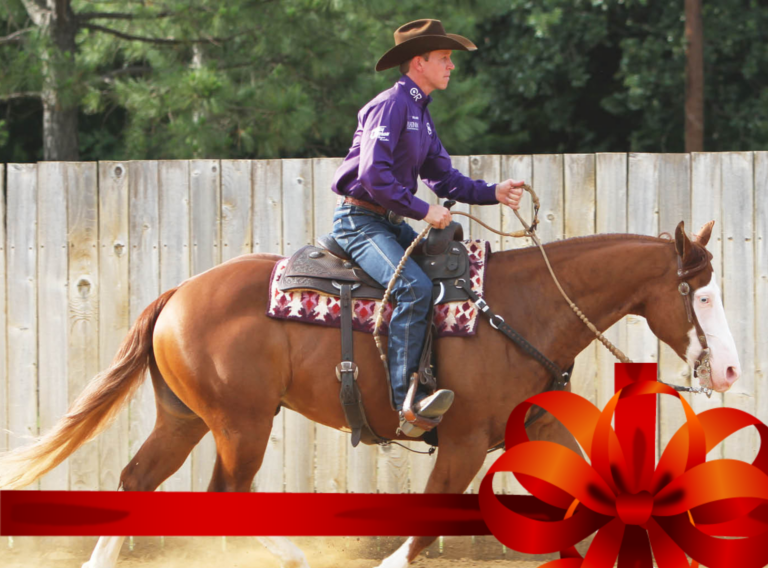Showmanship at halter tests you and your horse’s ability to confidently work as a team and execute a series of maneuvers on the ground. The great part about this class is that most horses of all price points can do it. I’ve seen horses that compete in reining, English, and Western pleasure events all be successful in showmanship.
[READ: FIX SHOWMANSHIP DULLNESS]
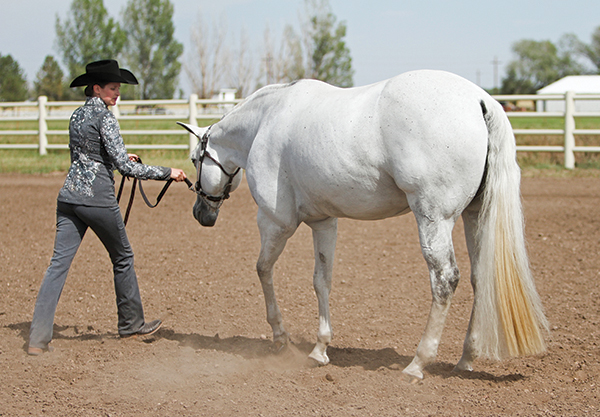
When done correctly, the horse and handler make a difficult pattern look effortless. But what you’re not seeing is the many hours spent at the barn perfecting each step that goes into acing a pattern. As a judge, it’s easy to spot which teams are putting in hours of practice at home. Horse and handler will have a strong connection and a steady rhythm through the entirety of the pattern.
To improve your score, look beyond the basics. Yes, your horse can back, but do you have full control over where he’s placing each foot? When you’re turning, are you making sure he stops with you?
Even if you’re crunched for time and can’t ride, it takes little effort to put a lead shank on your horse and spend 15 minutes working with him on the ground. Here I’ll explain how you can improve your showmanship score, and offer a few backing and turning exercises you can work on at home before your next show.
Backing Circles
A strong backup can be the difference between a first- and second-place showmanship pattern. To plus this maneuver, your horse must back readily with correctness and speed without your losing control.
When you’re executing a backup, stay to the side of your horse and extend your right arm across your body, leaving a slight bend in your elbow. To keep your horse from becoming crooked, look where you want to go and keep your shoulders and hips straight—avoid angling your shoulders and hips toward your horse’s head because this will push him off a straight track. Your horse should follow your body and be willing to back up without any resistance, and your hand should never leave the ring of the halter.
Backing a circle is a great way to gain more control and improve your horse’s back up. It also helps your horse stay rounded and underneath himself. As you begin circling, focus on guiding your horse’s hip and keeping his body arced in the same direction you’re circling. If you feel him start to drop his shoulder into the circle, give him a gentle tap with your hand or your lead shank to encourage him to stop leaning. If you do use your hand or lead shank to guide your horse, make sure it’s not a punishment. Instead, encourage him to put his body in the right position; don’t scare him. You can’t have a good connection with your horse if he’s fearful of you. This exercise will not only increase your control when you have to perform a circle in a class, it’ll also help improve your control during patterns that call for backing in a straight line.
[READ: SHOWMANSHIP STYLE TIP]
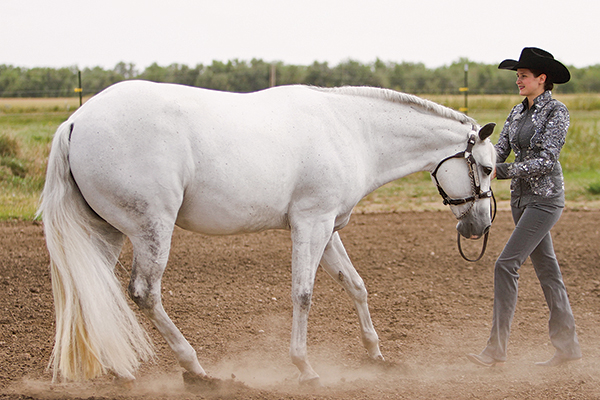

After you’ve mastered backing circles, you can mix it up by backing square corners. Don’t be afraid to challenge your horse by continuously going in different directions. You don’t need to go the same direction every time you ask him to do a square corner. Start by doing two left square corners, followed by a right square corner. Keep your horse’s body straight, and he should follow your lead no matter what direction you decide to go.
Bonus tip: If your horse likes to step wide or swing his hip to one side when you’re backing, you can also use this exercise to correct it. For example, if your horse favors backing to the left, immediately back a tight circle to the right, forcing his back feet to stay closer together and for him to stay underneath himself.
Clean Up Your Pivot
In an ideal showmanship pivot, your horse keeps his right hind foot planted for the duration of the right turn while the front left leg crosses over the front right leg. He keeps his neck and shoulders in a straight line through the turn, and he maintains a steady, rhythmic pace from start to finish. A steady pace helps your turn from bogging down and becoming a bore to watch, but don’t turn too fast and jeopardize accuracy. Going too fast can cause your horse to lose balance and move his pivot foot (which is a penalty), or it can cause you to miss the close of your turn and overspin.
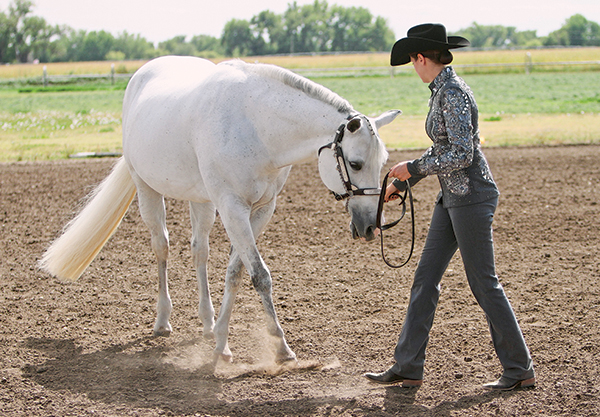
Body position is important when pivoting your horse. If you stand too far in front of him, you’ll pull him out of the turn. If you’re behind his throatlatch, you’ll push him out of the turn. I usually recommend staying in line with your horse’s eye, or a hair front of it, but that can vary depending on how your horse turns.
If you feel your horse anticipate turning and go without you, use a pull-turn exercise to focus his attention back on you. Start by turning your horse like you normally would. When you feel your horse start to get ahead of you, stop and immediately pull him back toward you and go into a pull turn for one or two steps. (Note: Pull turns are no longer permitted when showing, this is just for exercise purposes.)
While it’s important to stay in the pull turn until he wants to focus his attention back on you, limiting the turn to one or two steps will keep your horse from shifting his weight to his left hind leg and moving his pivot foot. You don’t want him to get into the habit of moving his right hind leg when you’re in the middle of a turn—even if it’s just for schooling purposes.
This exercise is also helpful if your horse doesn’t stop straight—or overturns—at the close of the pivot. If your horse stops a step or two after you do, immediately go back into your pull turn. After a few steps toward you, attempt your regular turn again. Do this until he’s following you and wants to stop when you do.
Bonus tip: It’s important to practice longer turns when you’re at home because most patterns call for multiple turns in a class and can vary in length. For example, you might do a 90-degree turn and then a 540-degree turn all in one pattern. You should both be comfortable turning different lengths.
[READ: BEST SHOW-HALTER FIT]
Bring a Buddy
Don’t forget the extra element of a judge being in the arena when you practice at home. Presenting your horse to the judge is an important piece of the pattern and merits practice to make perfect. When I’m judging showmanship, I often come across horses that are hesitant to approach me and will suck back—or stop—before they’re supposed to.
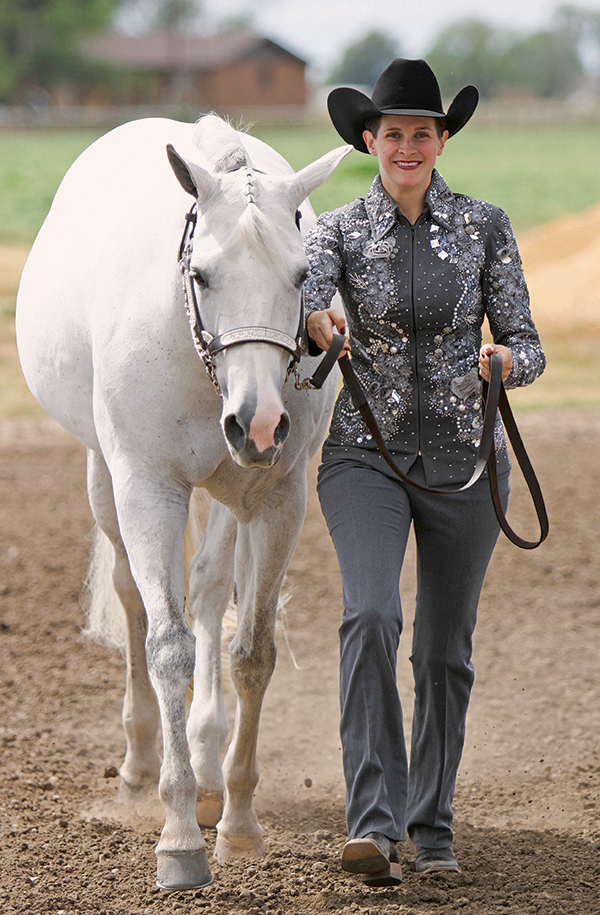
You can keep this from happening by having a friend stand in as your judge at home. Start simple by approaching your judge at a walk. If you feel your horse start to hesitate, gently pull him forward and get him to release off of the chain. You should stop at least an arm’s distance away from the judge. You don’t want your horse to try and touch or bite the judge, and you also don’t want to run into the judge when you’re crossing over during the inspection.
Once your horse is comfortable walking to the judge, increase the difficulty by going at a trot. Again, if he’s hesitant to trot, gently pull your horse forward and get him off the chain. There shouldn’t be any resistance when you’re trotting or walking to the judge. It might take more than one practice session before your horse is fully comfortable trotting or walking up to someone.
When you feel that you can confidently approach the judge, work on your presentation during the inspection. Have your friend walk around your horse so you can work on syncing up your crossovers in relation to where the judge is. It’ll also help your horse become comfortable with someone walking around him.
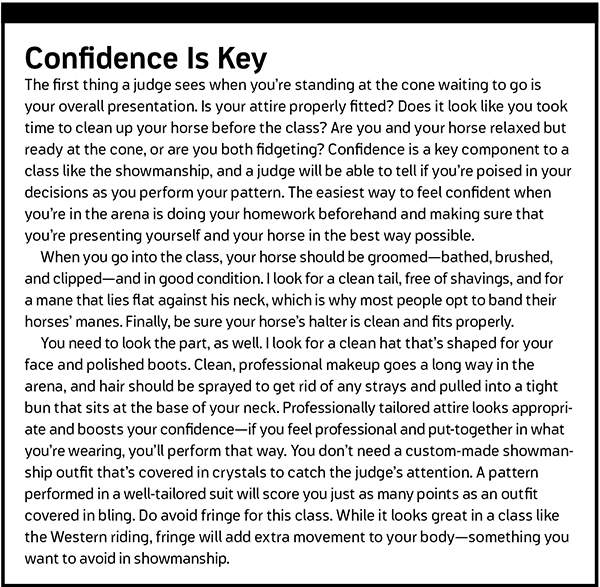
Bonus tip: It’s always great to have an extra set of eyes in the arena as you practice. When you’re working on approaching the judge, have your pretend judge watch to see if you’re staying straight or if you’re doing something to end up crooked.
Leslie Lange, Greeley, Colorado, owns and operates T&L Quarter Horses with her husband, Tom, and associate trainer Jeff Mellott. She’s an AQHA and NSBA judge and has trained and shown multiple world champions. In 2015 she was voted AQHA’s Most Valuable Professional.



